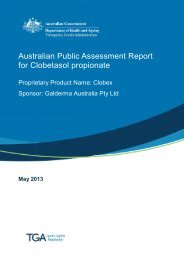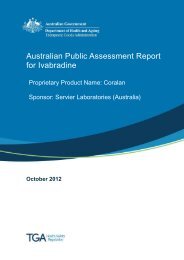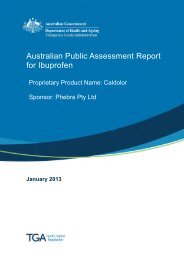CHMP position statement on Creutzfeldt-Jakob disease and plasma ...
CHMP position statement on Creutzfeldt-Jakob disease and plasma ...
CHMP position statement on Creutzfeldt-Jakob disease and plasma ...
You also want an ePaper? Increase the reach of your titles
YUMPU automatically turns print PDFs into web optimized ePapers that Google loves.
or any other process step or detecti<strong>on</strong> method where such correlati<strong>on</strong> is unclear. Cell-based assays<br />
may also be useful if properly validated for this purpose.<br />
Studies aimed at investigating the c<strong>on</strong>tributi<strong>on</strong> of the various manufacturing steps to reducti<strong>on</strong> of<br />
infectivity (including precipitati<strong>on</strong> followed by centrifugati<strong>on</strong> or depth filtrati<strong>on</strong>, chromatography <strong>and</strong><br />
nanofiltrati<strong>on</strong>) have accumulated c<strong>on</strong>vergent data supporting the removal of infectivity by steps that<br />
are comm<strong>on</strong>ly used in the manufacture of <strong>plasma</strong>-derived medicinal products. 66-72 In many cases,<br />
downstream steps using various precipitating agents or c<strong>on</strong>diti<strong>on</strong>s allow to discard PrP TSE in the<br />
precipitates. The reducti<strong>on</strong> level achieved may vary according to the specific manufacturing process,<br />
<strong>and</strong> probably depends <strong>on</strong> the c<strong>on</strong>centrati<strong>on</strong> of the precipitating agent <strong>and</strong> salts, <strong>and</strong> the pH.<br />
Chromatographic steps, classically used in the separati<strong>on</strong> of coagulati<strong>on</strong> factors but also in the<br />
purificati<strong>on</strong> of other <strong>plasma</strong> derivatives have been described to remove TSE infectivity or PrP TSE . Again,<br />
the reducti<strong>on</strong> factors may be variable according to the fracti<strong>on</strong> eluted. However, cauti<strong>on</strong> is still needed<br />
in the interpretati<strong>on</strong> of those data since the effectiveness of a given step is dependent <strong>on</strong> a number of<br />
variables including the process c<strong>on</strong>diti<strong>on</strong>s <strong>and</strong> the state/nature of the agent in the spiking preparati<strong>on</strong><br />
sample <strong>and</strong> in the spiked product intermediate. C<strong>on</strong>sequently, effectiveness of removal may vary from<br />
<strong>on</strong>e manufacturer to another. In additi<strong>on</strong>, recent studies have highlighted the fact that removal<br />
capacity may be variable according to the state of dispersi<strong>on</strong> of the agent in the spiking preparati<strong>on</strong><br />
particularly for steps based <strong>on</strong> retenti<strong>on</strong> mechanisms.<br />
There is a need to investigate the partiti<strong>on</strong>ing or removal capacities of the various fracti<strong>on</strong>ati<strong>on</strong> steps<br />
used in the preparati<strong>on</strong> of <strong>plasma</strong>-derived medicinal products. It is recommended to use various forms<br />
of spike preparati<strong>on</strong>s in order to get insight <strong>on</strong> their influence <strong>on</strong> the pri<strong>on</strong> reducti<strong>on</strong> at the specific<br />
investigated step as compared to what has been published in the literature. In specific cases, it might<br />
be worth c<strong>on</strong>sidering use of blood from infected animals as an alternative material for investigati<strong>on</strong> of<br />
early <strong>plasma</strong> processing steps, where feasible <strong>and</strong> where the overall pri<strong>on</strong> reducti<strong>on</strong> capacity seems<br />
limited or questi<strong>on</strong>able. There is further need for research to gain better knowledge of the form of<br />
infectivity present in blood in order to c<strong>on</strong>firm the relevance of the spiking material used in the<br />
validati<strong>on</strong> studies.<br />
8. Infectivity in urine<br />
The presence of PrP protein in urine has been reported. While this is a necessary c<strong>on</strong>diti<strong>on</strong> for the<br />
presence of the abnormal, infectious form, it is not evidence that infectivity is present, which derives<br />
from transmissi<strong>on</strong> experiments. 73,74<br />
Low levels of infectivity have been detected in urine of scrapie-infected rodents by several research<br />
groups <strong>and</strong> in the urine of deer with Chr<strong>on</strong>ic Wasting Disease. 5g Accordingly, urine has been reclassified<br />
am<strong>on</strong>g the category of “lower-infectivity tissues” by WHO. 10c<br />
Gregori et al. 75 dem<strong>on</strong>strated that the <strong>disease</strong> could be transmitted by intracerebral inoculati<strong>on</strong> of<br />
pooled urine from scrapie-sick hamsters. The infectivity titre of the urine was calculated to be around<br />
3.8 infectious doses/ml. Titrati<strong>on</strong> of kidney <strong>and</strong> urinary bladders from the same animals gave 20,000-<br />
fold greater c<strong>on</strong>centrati<strong>on</strong>s. Histologic <strong>and</strong> immunhistochemical examinati<strong>on</strong> of these tissues showed<br />
no indicati<strong>on</strong> of inflammati<strong>on</strong> or other pathologic changes, except for occasi<strong>on</strong>al deposits of <strong>disease</strong>associated<br />
pri<strong>on</strong> protein in kidneys.<br />
Kariv-Inbal et al. 76 have observed transmissi<strong>on</strong> of the <strong>disease</strong> after intraperit<strong>on</strong>eal administrati<strong>on</strong> of<br />
enriched urine fracti<strong>on</strong>s from scrapie sick hamsters. Transmissi<strong>on</strong> via the oral route was also<br />
investigated. The recipient hamsters remained without symptoms but sec<strong>on</strong>dary transmissi<strong>on</strong> was<br />
observed after inoculati<strong>on</strong> of brain extract from an asymptomatic hamster.<br />
11/26
















